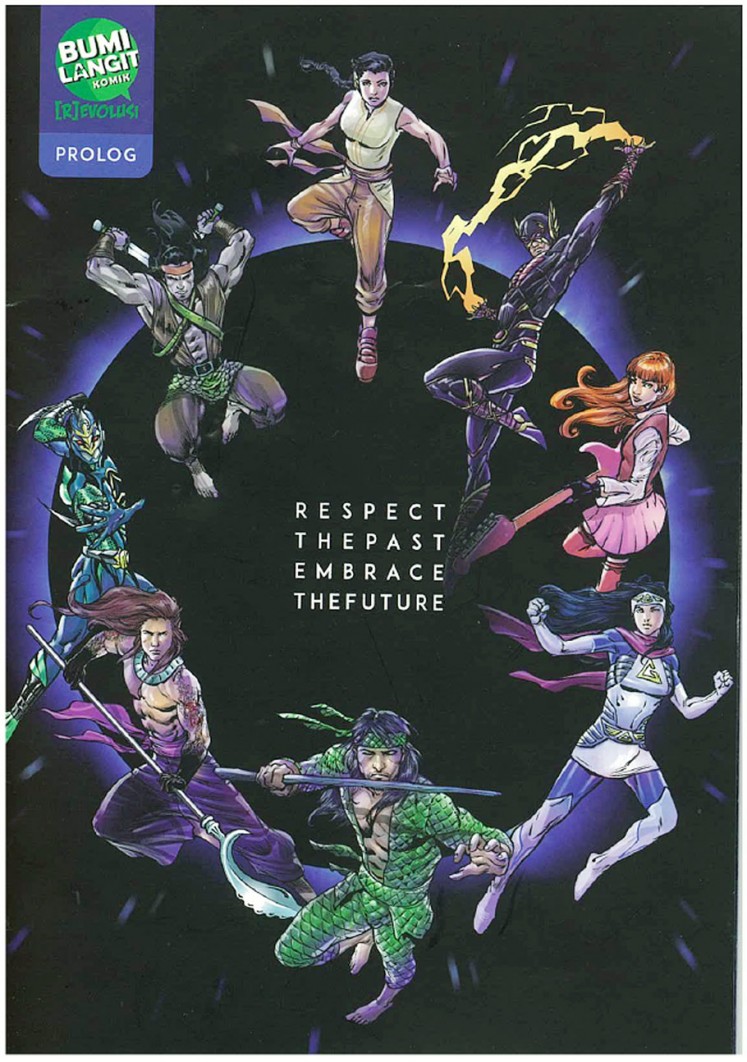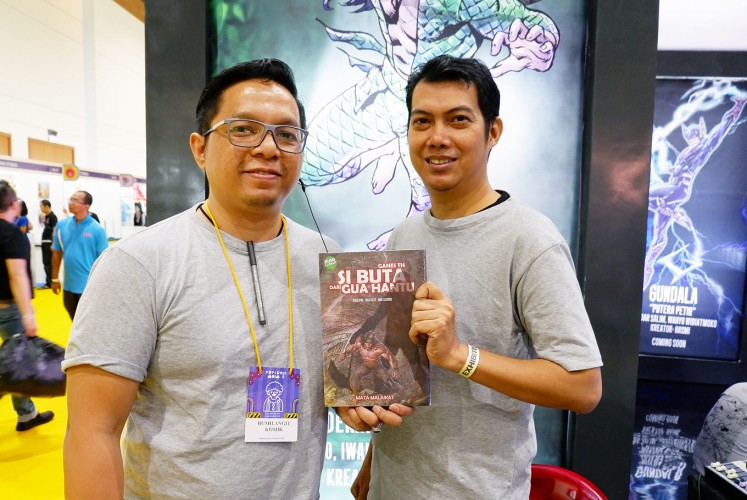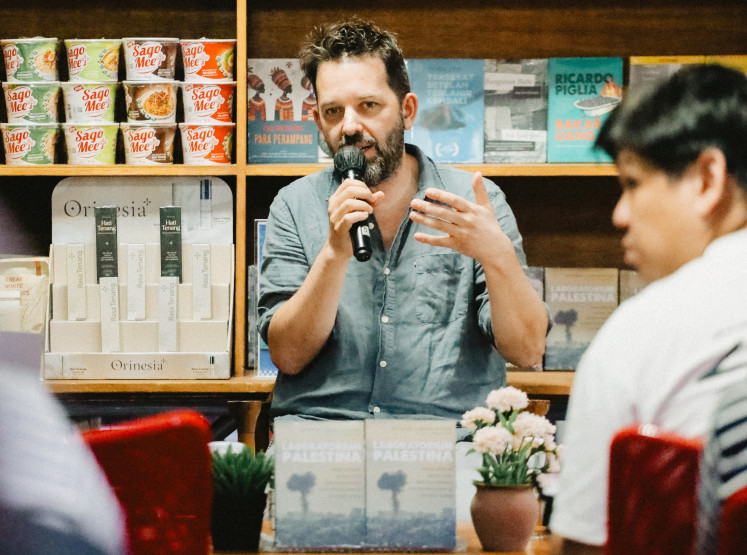Popular Reads
Top Results
Can't find what you're looking for?
View all search resultsPopular Reads
Top Results
Can't find what you're looking for?
View all search resultsBumi Langit [R]evolusi: Bringing back local superheroes
Indonesia has over 500 superhero characters you might never have heard of.
Change text size
Gift Premium Articles
to Anyone
I
f you spent your childhood in the 1990s, you might be familiar with soap opera series Si Buta dari Goa Hantu (The Blind Man from the Ghost Cave), which was about a blind martial artist Barda Mandrawata, who travels with a monkey on his shoulder to quell crime and violence as well as to avenge the death of his father, fiancé and colleagues.
Adapted from writer Ganes TH’s comic book series of the same name, the series was a hit at that time.
Si Buta, however, is not alone in the universe of Indonesian superheroes because the country has had over 500 superhero characters in the last 60 years.
Discovering that many young people have never heard of Indonesian superheroes, entertainment company Bumilangit launched a restoration project titled Bumi Langit [R]evolusi recently. In this project, 21 writers and illustrators teamed up to work on a remake of legendary comic books.
Bumilangit recorded that over 60 years there were 50 comic titles about 200 warrior characters and 110 comic titles about 300 superhero characters, including Sri Asih, Indonesia’s first female superhero who made her first appearance in 1954. Although the creation of Sri Asih was inspired by Wonder Woman, her wardrobe strongly represented Javanese tradition.
Out of the 500 characters, eight characters have been chosen by Bumilangit for Bumi Langit [R]evolusi. They are Sri Asih created by RA Kosasih, Si Buta by Ganes TH, Mandala by Mansyur Daman, Virgo by Jan Mintaraga, Gundala and Maza by Harya Suraminata and Godam and Aquanus by Wid NS.
Bumilangit assigned the remake version of the Si Buta story to writer Oyasujiwo, who won the Komikasia Award 2005 and Kosasih Award 2007, and illustrator Iwan Nazif, who had a hand in DreamWorks’s comic series How to Train Your Dragon.
Recreated: Comic writers Iwan Nazif and Oyasujiwo hold the remake of comic book Si Buta dari Goa Hantu. (JP/A. Kurniawan Ulung)“This December marks the 50th anniversary of Si Buta dari Goa Hantu, which debuted in 1967,” Oyasujiwo said during the recent Popcon Asia 2017 event in Jakarta.
Bumilangit have recreated the original comics with changes that were adapted to present-day conditions because they want to attract young readers.
“In the original comic, Maza is a painter. But, in the remake version, he is an urban artist who has the power to manipulate dreams,” Oyasujiwo said.
“Gundala is still a scientist. But, in the new comic, he has a YouTube channel about science.”
Oyasujiwo said that changes also occurred in the storytelling and visualization of character illustration.
For the changes, Bumilangit has received permission from the original writers or their children, such as Ginardi Santosa, the son of Ganes, who passed away in 1995, and Fajar Sungging Pramodito, the son of Wid NS, who died in 2003.
The remake of Si Buta dari Goa Hantu, which took six months to complete, has hit bookstores. Meanwhile, the remakes of seven other superheroes are still being processed.
Bumilangit’s comic series are also posted on its Facebook account to accommodate readers who want to read them online for free.
Before being published in the printed version, the remake of Si Buta dari Goa Hantu received mixed responses from its readers on Facebook, which has over 54,000 followers.
Recreated: Comic writers Iwan Nazif and Oyasujiwo hold the remake of comic book Si Buta dari Goa Hantu. (JP/A. Kurniawan Ulung)Oyasujiwo recalled that he was praised by new readers for changes and improvisations that he made, but he was criticized by some of loyal readers of Ganes’ works.
“It is so challenging to bridge new readers and old readers. I cannot satisfy all parties,” the 42-year-old said.
Oyasujiwo, who has published more than 30 children’s books since he was 15, also deepened stories and characterizations in the remake of Si Buta dari Goa Hantu. Barda’s emotions, for example, are revealed after he loses his fiancé and father.
“I also explain how his enemy, Si Mata Malaikat [The Angel Eye], becomes evil and lights the spark. You will not find that part in the original comic,” he said.
According to Oyasujiwo, the popularity of Indonesian comic books began to decline with the emergence of translated comic books in 1980s, such as Petualangan Tintin (The Adventures of Tintin) by Indira publishing company and Superman by Cypress publishing company.
Local comic writers lost more readers when translated Japanese comic books, such as Doraemon, Kungfu Boy and Dragon Ball, circulated in the 1990s.
In 1995, he added, comic writer Ahmad Toriq published superhero comic Caroq, which tells of taxi driver Ongko who becomes a superhero armed with two long magical sickles. However, it failed to survive in the market because it was overshadowed by translated American and Japanese comic books.
Oyasujiwo observed that Indonesian comic lovers began to be interested in local superheroes after the success of comic strip Benny & Mice by cartoonists Benny Rachmadi and Muhammad Misrad, which first appeared in the Sunday edition of the Kompas newspaper in 2003.
Bumilangit, which believes that everybody needs a hero that they can be proud of, is on cloud nine today because local comic writers already have die-hard fans thanks to social media sites where they can introduce and promote their work in digital format.
“[Social media] widens our access so that our comics can be accessed by millions of people. Now, we have appeared on the surface,” he said.













